 Charlotte Amalie, capital of the U.S. Virgin Islands | |
| Geography | |
| Location | Caribbean Sea North Atlantic Ocean |
| Coordinates | 16°N 61°W / 16°N 61°W |
| Total islands | 30+ |
| Major islands | Antigua and Barbuda Guadeloupe Montserrat Saint Kitts and Nevis Saint Martin Virgin Islands |
| Highest elevation | 1,467 m (4813 ft) |
| Highest point | La Grande Soufrière, Guadeloupe |
| Administration | |
| Largest settlement | St. John's |
| Largest settlement | Les Abymes |
| Largest settlement | Basseterre |
| Largest settlement | Philipsburg |
| Demographics | |
| Population | c. +700,000 |
The Leeward Islands (/ˈliːwərd/) are a group of islands situated where the northeastern Caribbean Sea meets the western Atlantic Ocean. Starting with the Virgin Islands east of Puerto Rico, they extend southeast to Guadeloupe and its dependencies. In English, the term Leeward Islands refers to the northern islands of the Lesser Antilles chain. The more southerly part of this chain, starting with Dominica, is called the Windward Islands. Dominica was originally considered a part of the Leeward Islands, but was transferred from the British Leeward Islands to the British Windward Islands in 1940.
Origin of the name
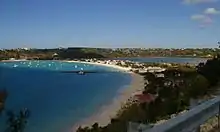
The name of this island group, Leeward Islands, dates from previous centuries, when sailing ships were the sole form of transportation across the Atlantic Ocean. In sailing terminology, 'windward' means towards the source of the wind (upwind), while 'leeward' is the opposite direction (downwind). In the West Indies, the prevailing winds, known as the trade winds, blow predominantly out of the northeast. Therefore, a sailing vessel departing from the British Gold Coast and the Gulf of Guinea, driven by the trade winds, would normally first encounter Dominica and Martinique,[1] islands most to windward, in their west-northwesterly heading to the final destinations in the Caribbean, Central America, and Northern America.[2] This location, Dominica and Martinique, becomes the rough dividing line between the Windward Islands and the Leeward Islands.
The early Spanish explorers called Puerto Rico and the islands to the west Sotavento, meaning 'leeward'. The islands to the south and east of Puerto Rico were then called Islas de Barlovento, meaning 'windward islands'. When the British gained control of many of the Lesser Antilles, they designated Antigua, Montserrat and the islands to the north as the 'Leeward Islands'. Guadeloupe and the islands to the south were designated as the 'Windward Islands'. Later on, all islands north of Martinique became known as the Leeward Islands.[3] Dominica was transferred to the British Windward Islands in 1940, and is now considered part of the Windward Islands.[4]
However, even in modern usage in languages other than English, notably, Dutch, French, and Spanish, all of the Lesser Antilles from the Virgin Islands to Trinidad and Tobago are known as 'the Windward Islands' (Bovenwindse Eilanden in Dutch, Îles du Vent in French, and Islas de Barlovento in Spanish). The ABC islands and the other islands along the Venezuelan coast, known in English as the Leeward Antilles, are known in languages other than English as 'the Leeward Islands'.
Geography
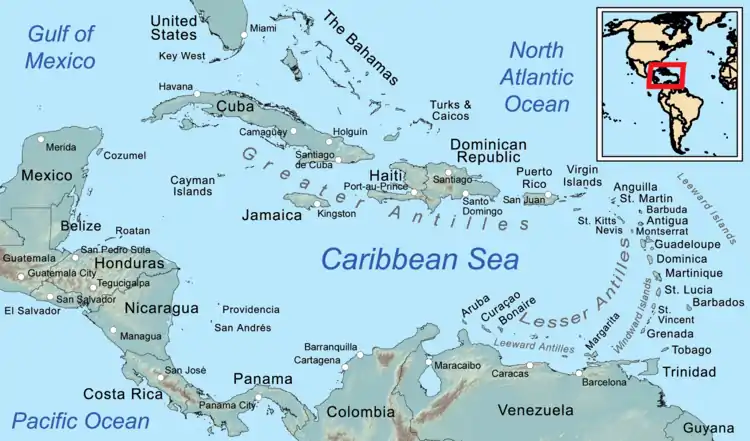
The islands are affected by active volcanism, and notable eruptions occurred in Montserrat in the 1990s and in 2009 to 2010. At 1,467 metres or 4,813 feet, the highest point is La Grande Soufrière in Guadeloupe.
History
The Caribs, after whom the Caribbean is named, are believed to have migrated from the Orinoco River area in Venezuela in South America to settle in the Caribbean islands about 1200 AD, according to carbon dating. Over the century leading up to Columbus' arrival in the Caribbean archipelago in 1492, the Caribs mostly displaced the Maipurean-speaking Taínos, who settled the island chains earlier in history, by warfare, extermination and assimilation.[5]
The islands were among the first parts of the Americas to fall under the control of the Spanish Empire. European contact commenced with Christopher Columbus's second voyage; many of the islands' names originate from this period: Montserrat was named in honour of Santa Maria de Montserrat (Our Lady of Montserrat), after the Blessed Virgin of the Monastery of Montserrat, which is located on the Mountain of Montserrat, the national shrine of Catalonia. 'Mont serrat' in Catalan means 'saw mountain', referring to the serrated appearance of the mountain range.
British colony of the Leeward Islands
The Leeward Islands became a British colony in 1671, with William Stapleton as its first governor.
Although comparatively much smaller than the surrounding islands in the Caribbean, the Leeward Islands posed the most significant rebellion to the British Stamp Act, though it was decidedly less severe in comparison to that of the mainland North American colonies.[6]
In 1660, there were about 8,000 white settlers and approximately 2,000 African slaves in the Leeward Islands. However, that ratio narrowed over succeeding years. In 1678, there were 10,408 white settlers and 8,449 black slaves. By 1708, there was a huge disparity between the number of white settlers, which had declined to 7,311, while the number of black slaves was estimated at 23,500.[7]
In 1816, the colony as a federation of islands was dissolved, and the individual islands were ruled individually. However, the colony of the Leeward Islands was re-established in 1833.[8]
List of notable islands in the Leeward Islands
There are two countries and eleven territories in the Leeward Islands. From the northwest to the southeast, the main islands are:
- Virgin Islands
- Spanish Virgin Islands
 U.S. Virgin Islands (United States)
U.S. Virgin Islands (United States)
 British Virgin Islands (United Kingdom)
British Virgin Islands (United Kingdom)
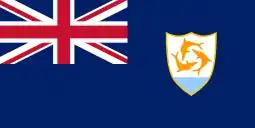 Anguilla (United Kingdom)
Anguilla (United Kingdom)- Saint Martin Island
.svg.png.webp) Saint Barthélemy (France)
Saint Barthélemy (France) Saba (Netherlands)
Saba (Netherlands)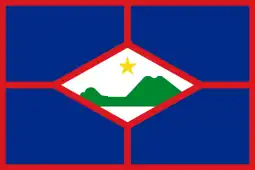 Sint Eustatius (Netherlands)
Sint Eustatius (Netherlands)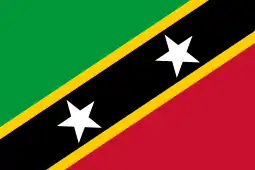 Saint Kitts and Nevis
Saint Kitts and Nevis
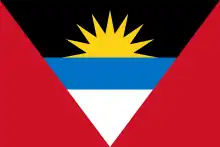 Antigua and Barbuda
Antigua and Barbuda
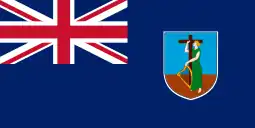 Montserrat (United Kingdom)
Montserrat (United Kingdom)_variant.svg.png.webp) Guadeloupe (France)
Guadeloupe (France)
- La Désirade (dependency of Guadeloupe) — literally 'The Desired', also called La Deseada[9]
- Îles des Saintes (dependency of Guadeloupe)
- Marie-Galante (dependency of Guadeloupe)
See also
- Leeward Islands moist forests
- British Leeward Islands
- Leeward Antilles
- Leeward Islands Cricket Association
- Leeward Islands cricket team
- Lesser Antilles
- Lesser Antilles topics
- Leeward Islands topics
- Windward Islands topics
- Southern Caribbean
- Windward Islands
References
- ↑ "Windward Islands Map — Leeward Islands Map — Satellite Image". geology.com. Retrieved 2020-11-20.
- ↑ Sauer, Carl O. (1966). The Early Spanish Main. Berkeley: University of California Press. p. 192.
The current convention that the Leeward Islands (Sotavento) run from Guadeloupe to St. Croix records the Spanish practice of sailing to their leeward and may go back to the time of Columbus [who arrived at the Dominica Passage on his 2nd voyage]
- ↑ J. C. Hart and W. T. Stone (1982), A Cruising Guide to the Caribbean and the Bahamas, Dodd, Mead & Co., p. 601, ISBN 0-396-08023-5.
- ↑ "The Leewards". The New York Times. 20 December 1964. ISSN 0362-4331. Retrieved 11 November 2021.
The Leeward Islands, a cluster of isles in the Caribbean under United States, British, Dutch and French flags, are strung out in a 400-mile‐long arc between Puerto Rico and Martinique. The group takes its name from the geographic fact that it is farther from the direct route of the rain‐carrying northeasterly trade winds than the neighboring Windward Islands. One of the islands, Dominica, is geographically part of the Leewards, but, since 1940, has been politically and administratively part of the British Windioard Islands.
- ↑ Sweeney, James L. (2007). "Caribs, Maroons, Jacobins, Brigands, and Sugar Barons: The Last Stand of the Black Caribs on St. Vincent" Archived 2012-02-27 at the Wayback Machine, African Diaspora Archaeology Network, March 2007, retrieved 26 April 2007.
- ↑ O'Shaughnessy, Andrew (April 1994). "The Stamp Act Crisis in the British Caribbean". The William and Mary Quarterly. 51 (2): 203–226. doi:10.2307/2946860. JSTOR 2946860. S2CID 144862560.
- ↑ Hilary Beckles, "The 'Hub of Empire': The Caribbean and Britain in the Seventeenth Century", The Oxford History of the British Empire: Volume 1 The Origins of Empire, ed. by Nicholas Canny (Oxford: Oxford University Press, 2001), p. 224.
- ↑ "LC Name Authority File (LCNAF) — Leeward Islands (Federation)". id.loc.gov. The Library of Congress. Retrieved 23 December 2020.
- ↑ The American Universal Geography, Jedidiah Morse, 7ed. v1, Charlestown, 1819.
Further reading
- Jeppe Mulich. 2020. In a Sea of Empires: Networks and Crossings in the Revolutionary Caribbean. Cambridge University Press.
External links
- Digital Library of the Caribbean−dloc.org: "The Leeward Islands Gazette"—freely−openly available, with full page images and searchable text
- Digital Library of the Caribbean−dloc.org: "Antigua, Montserrat and Virgin Islands Gazette"—openly−freely available, with searchable text and full page images
